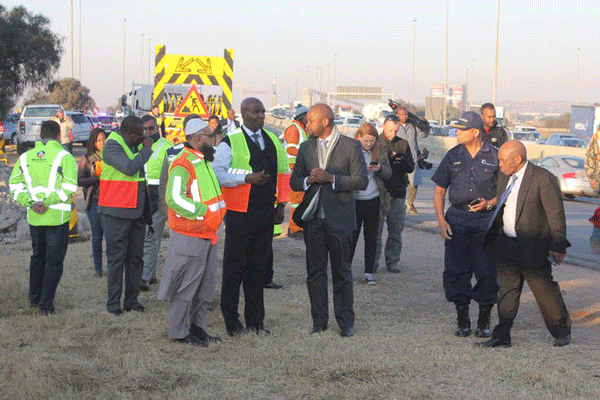SANRAL pros are the people you want in an emergency on our national roads.

Within minutes after a disused pedestrian bridge across the busy N3 freeway in Gauteng collapsed in August 2017, a team of professionals from the South African National Roads Agency (SOC) Limited (SANRAL) was on the scene to investigate.
Their investigation revealed the collapse had been caused by an impact on the supporting central pillar.
Evidence suggested the impact came from an 18.1-ton coil of steel. The coil was found 100m north of the collapsed bridge and marks on the road led directly from the point of impact to the position where the coil came to rest.
It is the task of SANRAL to ensure the safe movement of all road users, and monitoring the state of bridges across the national roads is just one of the agency’s many tasks.
Bridges and culverts
Bridges and culverts are essential structures along the more than 22 000km of national road network managed and maintained by SANRAL. These roads are the vital arteries of the South African economy.
SANRAL looks after the structural health and safety aspects of more than 9 500 bridges longer than 2.1m, as well as culverts with openings greater than 5m². These include 903 bridges on the major cross-country freeways operated by the public-private concessionaires along the N1, N3 and N4.
“The bridges on South Africa’s national roads are world-class in terms of design, construction and maintenance,” said SANRAL’s Bridge Network Manager, Edwin Kruger.
No details are spared during the design and construction phases and once the bridges are built, they are maintained, cared for and inspected rigorously.
Each of the bridges and culverts are assessed by SANRAL-accredited inspectors over a rolling five- to six-year period. These include structures that are no longer in use, such as the old pedestrian bridge across the N3, which was found to be in excellent shape in its most recent inspection.
In recent years, SANRAL has incorporated a number of roads that were previously managed by provincial administrations in the Eastern Cape, Limpopo and Mpumalanga.
The first action taken is to conduct a thorough investigation of the entire road structure – including its bridges and culverts – and to do maintenance work that will ensure that the roads comply with SANRAL’s quality standards.
“All bridges and culverts on SANRAL’s network were inspected over the past two years to ensure the safety of the public crossing over or under the bridges,” said Kruger.
The rehabilitation of a bridge starts at the design stage, he explained. The normal life of a bridge is between 50 and 100 years.
“SANRAL’s role is to ensure the highest standards of design and construction are met by the professionals and contractors involved in the project,” Kruger said.
Defects can occur over years due to a number of factors including age, accidental damage, extreme weather, or natural events such as earthquakes and tremors.
Bridge management system
During its regular inspections, SANRAL uses a Bridge Management System to determine both the structural condition and aesthetic quality of the bridge.
Only qualified structural bridge engineers with specialised training and experience are used and each bridge is evaluated according to an exhaustive set of criteria.
Depending on the results of the inspections, SANRAL professionals will decide whether repairs are required.

